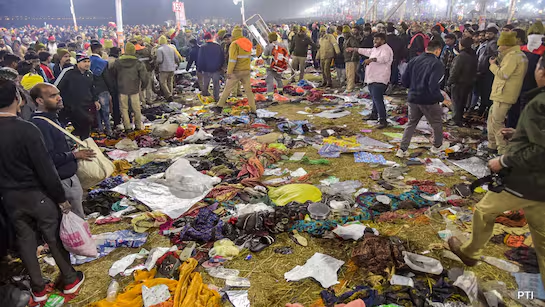A deadly stampede broke out at the Maha Kumbh Mela in Prayagraj early on Wednesday, January 29, as crores of devotees gathered to mark the sacred Mauni Amavasya. The incident, which occurred around 2:30 am at the Triveni Sangam, resulted in the tragic deaths of at least 30 people and left over 60 injured.
The crowd surge, sparked by the overwhelming influx of pilgrims eager to participate in the ‘Amrit Snan’ (holy dip), caused chaos and panic, as hundreds of devotees were trampled in the stampede.
Among the casualties were women and elderly individuals, with many others crushed under the pressure of the uncontrolled crowd. Authorities rushed to the scene, with rescue teams working tirelessly to transport the injured to medical facilities.

Devastated by the tragedy, several akharas—religious groups—called off their participation in the Amrit Snan, including Juna Akhara and the Akhil Bharatiya Akhara Parishad. Mahant Ravindra Puri, president of the Akhara Parishad, expressed his sorrow and announced the cancellation of the ritual, citing safety concerns. The Panchayati Mahanirvani Akhara also halted its participation, with seers deeming the situation “unsuitable” for the sacred dip due to the overwhelming crowd.
Uttar Pradesh Chief Minister Yogi Adityanath appealed to the public to refrain from heading to the Sangam and instead take the holy dip at other ghats to prevent further escalation. Despite the tragedy, the state government reassured the public that medical teams were working to manage the crisis, with several ghats designated for safe bathing. The authorities have also launched an investigation into the cause of the stampede.
The incident, which occurred on one of the holiest days of the month-long festival, has reignited concerns over crowd management at religious events in India. The Kumbh Mela, which attracts millions of pilgrims, has seen previous stampedes, with notable incidents in 1954 and 2013 resulting in substantial loss of life.
Opposition leaders, including Samajwadi Party chief Akhilesh Yadav, have condemned the incident, blaming poor crowd management and the prioritisation of VIPs over ordinary devotees. Yadav called for the army to take over the management of the Kumbh Mela to restore faith in the system and prevent further incidents.
The stampede occurred just ahead of the Brahma Muhurta, the auspicious time for the holy dip. As devotees flocked to the ghats in the dark hours of the morning, the situation became chaotic, with many people, including those sitting near barricades, caught in the crushing surge. Survivors described the horrific scene, where elderly people and women were suffocated under the weight of the crowd, with no help in sight.
The state government had anticipated a crowd of up to 100 million for Mauni Amavasya, but the overcrowding and lack of adequate measures led to this tragic loss of life. Authorities had deployed drones and surveillance cameras to monitor the crowd, but despite these efforts, the disaster unfolded.
Prime Minister Narendra Modi and opposition leader Rahul Gandhi both expressed their condolences, with Modi assuring the public that the local administration was doing everything possible to assist the victims. Gandhi attributed the disaster to mismanagement and called for improvements to the system, urging the government to prioritise the safety of common devotees over VIPs.
With more ritual bathing days scheduled during the remaining weeks of the Kumbh Mela, the incident has raised urgent questions about the safety and management of the festival, as millions of pilgrims continue to arrive in Prayagraj.
Support Our Journalism
The global Indian Diaspora and Australia’s multicultural communities need fair, non-hyphenated, and questioning journalism, packed with on-ground reporting. The Australia Today—with exceptional reporters, columnists, and editors—is doing just that. Sustaining this requires support from wonderful readers like you.

Whether you live in Australia, the United Kingdom, Canada, the United States of America, or India you can take a paid subscription by clicking Patreon





